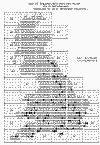 |
Map
of England and Wales (Grid Referenced) Location of Wild Honeybee Colonies Click image to see full size. |
|
The Hollow
Tree Experiment
(c)
Copyright Ian Rumsey
|
|
Varroa arrived in Essex during 1996 and the winter of 1997/8 brought devastation to beekeepers in the area. From my swarm collecting activities it was apparent
that wild bee colonies had not suffered, also one of my own colonies survived
in a home made hive, which developed into the 'Hollow Tree' experiment. To investigate this situation further I wrote
to local newspapers in England and Wales requesting information regarding
wild bee colonies and received over 100 reports. This led me to believe that the breed of bee was
unimportant and perhaps the habitat and environment were deciding factors. In 1998 I collected two swarms and placed them
in 'HT' hives 8 & 16, numbered the 1997 'HT ' hive No 4, and commenced
a weekly varroa drop count on all three in May. During 1999 I continued with the varroa drop count
for hives 4,8,& 16 and housed and monitored a further 4 swarms in
'HT' hives 1,3,6,& 12. From
these results I have made the following observations (1). Bees naturally groom themselves free of the
varroa mite. (2).The
'HT' hive does not allow groomed varroa mites to rejoin the colony (3).Bees
naturally uncap cells containing unhealthy brood and remove the contents, (4).There are two limiting factors preventing uncontrolled varroa increase.
5). Periods where there is a reduction of brood resulting in excessive
numbers of mites. searching for a reducing number of nest sites causes
an increase in grooming and cell uncapping due to multiple mite infestation. (6).The
number of varroa bred in a colony is not in direct proportion to the size
of the If a colony of 10,000 bees in a nest site of 1 cubic foot breeds 1000 varroa
per year, This is due to large colonies
breeding more drones allowing a more rapid varroa build up. (7).There is a limit to the number of varroa a given quantity of bees can
groom. Where the depth of comb increases in proportion with the hive capacity,
and the distances travelled by the mite to reach drone brood increases
accordingly, the bees have a proportional increase in grooming opportunity,
and this compensation is sufficient to ensure the survival of larger colonies. The varroa drop count for the years 1998 &
1999 for colonies of bees housed in untreated 'Hollow Tree' hives follow,
together with other self-explanatory information. In April 2000 I applied for a patent for this
type of hive and the patent specification is also included. My results and observations are not important,
but if other people, in other places, with other bees, obtain the same
results and arrive at the same conclusions, then my patent may have some
intrinsic value. |
 |
Map
of England and Wales (Grid Referenced) Location of Wild Honeybee Colonies Click image to see full size. |
| The
hive consists of sections, about 6 inches deep, stacked upon each other.
Sections are added at the bottom as the size of the colony increases to
maintain a 6 inch gap beneath the comb. Each section has an outside measurement of 14 inches. The thickness of the wood being between 1 & 2 inches. The entrances are 1 inch diameter holes drilled in the sections as required. The roof is a piece of board 16 inches square 1-2 inches thick positioned on top. At least two entrances are provided for ventilation purposes. |
| The
comb depth will reach 32 inches after 2 years. In the third year no increase was observed. The floor debris is observed each week. |

|

Barely,
barely, quite contrary,
That's
how my varroa grow,
I keep my bess, in hollow trees,
All in a row.
|
An
Explanation regarding the Survival of Wild Bee Colonies |
|
Grooming
and the uncapping of cells containing deformed embryo bees is sufficient
to limit the varroa mite population in wild colonies and is most apparent
when there are more |
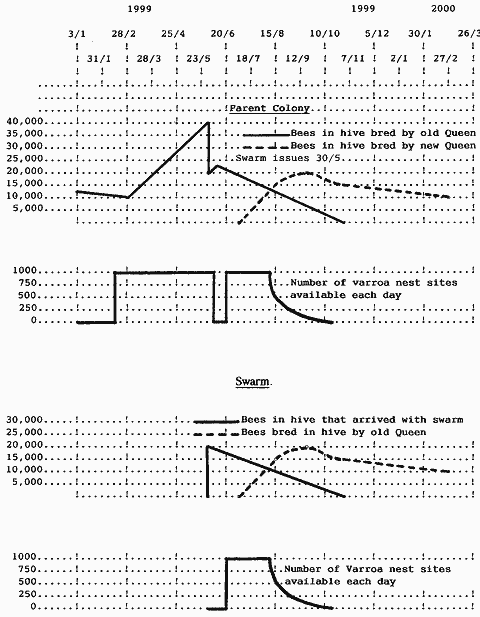
|
Peaks
in the varroa drop count should coincide with the 'more mites than sites'
situation which occur around 6/6, 8/8 and 10/10. Weekly
Varroa Drop 1998 |
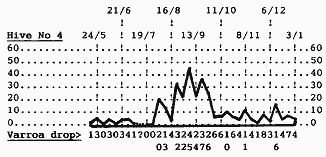
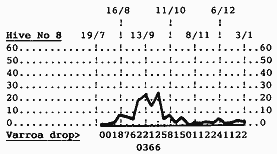
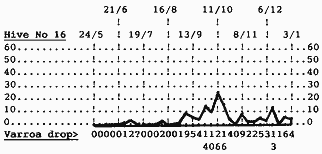
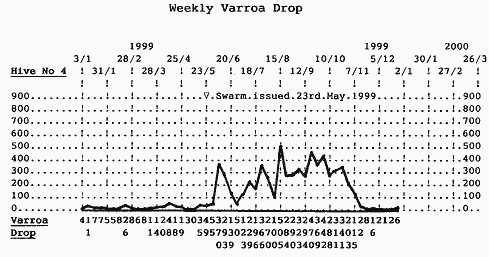
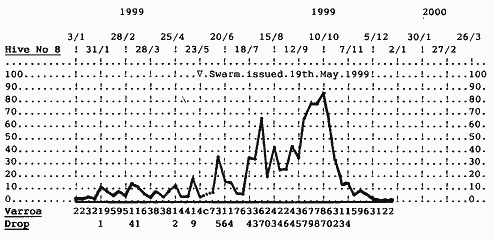

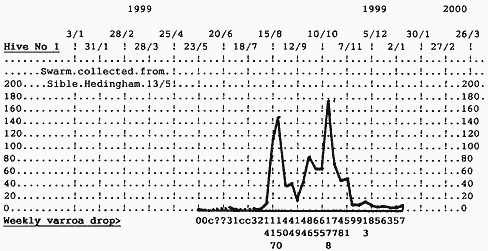


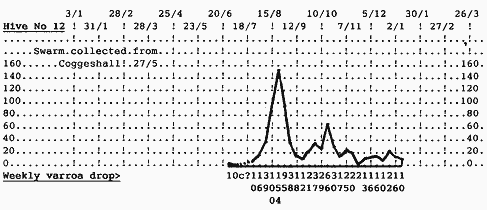
|
Copy of 'Hollow Tree' experiment sent to interested beekeepers contacted during survey The
Hollow Tree Hive The object of the Hollow Tree Hive is to reproduce in a convenient and
monitorable
Fig 1 Fig 2 The hive is then placed on an old 'National' floor. A piece of white formica 12 inches square is placed under the hive, covered with a thin coat of vaseline just sufficient to make the debris stick. To renew each week lift base of hive with hive tool at the front. Slide old formica square out and new one in. A wire loop fixed to the square is useful. No other interference is allowed, no smoke, no bayvarol, no honey, no end of interest. If the weekly varroa drop of dead mites exceed the MAFF requirement for treatment destroy colony. The experiment has failed. The graph underneath may be useful to plot weekly progress |

|
Copy
of Patent specification as applied for in the United Kingdom |
|
Bee Hive |
|
This invention relates to a Bee Hive |
|
Bee
hives in Great Britain have been infested with the varroa mite since
1992. |
|
A wild bee colony would construct a nest where the comb would be circular the size of a dinner plate, and a series of these would be constructed, as placed in a plate rack. The honey stores would be in the top portion, the worker brood in the centre, with the drone brood underneath. |
|
Varroa mites prefer to undertake their breeding cycle in drone brood when available. The frames in the brood box of a conventional bee hive are much longer than they are deep which flattens the nest shape into an ellipse with the major axis being horizontal. The honey store is now much closer to the drone brood and in consequence the necessary activity of the varroa mite during the breeding cycle is much reduced. |
|
According to the present invention the Bee Hive is constructed to contain conventional size brood frames but rotated through 90° so that they are much deeper than they are wide which elongates the nest shape into an ellipse with the major axis being vertical. This increases the distances that have to be traversed by the varroa mite during its reproduction cycle which enhances the period of possible grooming which is sufficient to limit the varroa population allowing bees and varroa to live harmoniously together without treatment. |
|
A specific embodiment of the invention will now be described by way of example with reference to the accompanying drawing in which- |
|
Figure 1 shows the front and side elevation. |
|
Figure 2 shows the cross section XX |
|
Referring to the drawing the Bee Hive comprises of a Roof 1 and a Hive Body 2 which stands on a Floor 3. The Hive Body contains six conventional bee hive brood frames 4 rotated through 90° and mounted in parallel. The hive Entrance is positioned at 5 and the Space 6 is provided above Floor 3. |
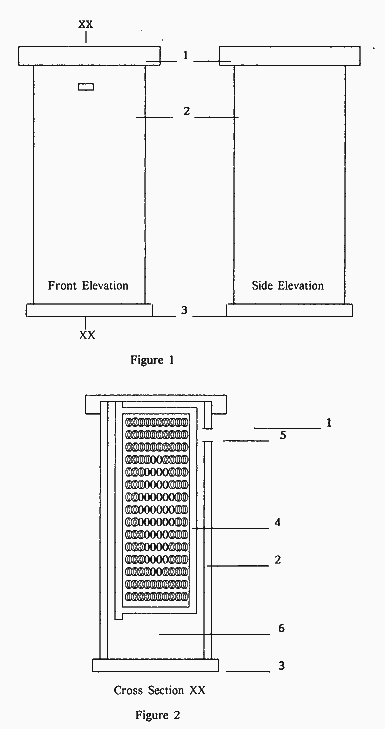
|
Wild colony in hedge |
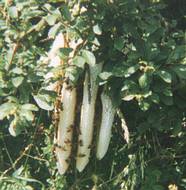 |
|
Side View |
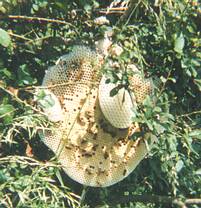 |
|
Front View |